MERCEDES-BENZ E-Class WAGON 2016 W213 Owner's Manual
Manufacturer: MERCEDES-BENZ, Model Year: 2016, Model line: E-Class WAGON, Model: MERCEDES-BENZ E-Class WAGON 2016 W213Pages: 350, PDF Size: 6.71 MB
Page 311 of 350

Occupant distribution
The distribution of occupants in a vehicle at
their designated seating positions.
Total load limit
Nominal load and luggage load plus 68 kg
(150 lbs) multiplied by the number of seats in
the vehicle.
Changing a wheel
Flat tire
The "Breakdown assistance" section
(
Ypage 271) contains information and notes
on how to deal with a flat tire. Information on driving with MOExtended tires in the event of
a flat tire can be found under "MOExtended
tires (tires with run-flat characteristics"
(
Ypage 272).
Vehicle with emergency spare wheel: in
the event of a flat tire, the emergency spare
wheel is mounted as described under "Mount-
ing a wheel" (
Ypage 309).
Rotating the wheels
GWARNING
Interchanging the front and rear wheels may
severely impair the driving characteristics if
the wheels or tires have different dimensions. The wheel brakes or suspension components
may also be damaged. There is a risk of acci-
dent.
Rotate front and rear wheels only if the wheels and tires are of the same dimensions.
!On vehicles equipped with a tire pressure
monitor, electronic components are loca-
ted in the wheel.
Tire-mounting tools should not be used
near the valve. This could damage the elec- tronic components.
Only have tires changed at a qualified spe-
cialist workshop. Always observe the instructions and safety
notes in the "Mounting a wheel" section
(
Ypage 309).
The wear patterns on the front and rear tires
differ, depending on the operating conditions.
Rotate the wheels before a clear wear pattern
has formed on the tires. Front tires typically
wear more on the shoulders and the rear tires
in the center.
If your vehicle's tire configuration allows, you
can rotate the wheels according to the inter-
vals in the tire manufacturer's warranty book
in your vehicle documents. If no warranty
book is available, the tires should be rotated
every 3,000 to 6,000 miles (5,000 to
10,000 km), or earlier if tire wear requires. Do
not change the direction of wheel rotation.
Clean the contact surfaces of the wheel and
the brake disc thoroughly every time a wheel
is rotated. Check the tire pressure and reac-
tivate the tire pressure monitor if necessary
(
Ypage 297).
Direction of rotation
Tires with a specified direction of rotation
have additional benefits, e.g. if there is a risk of hydroplaning. These advantages can only
be gained if the tires are installed correspond-
ing to the direction of rotation.
An arrow on the sidewall of the tire indicates its correct direction of rotation.
Storing wheels
Store wheels that are not being used in a cool,
dry and preferably dark place. Protect the
tires from oil, grease, gasoline and diesel.
Mounting a wheel
Preparing the vehicle
XStop the vehicle on solid, non-slippery and
level ground.
XApply the parking brake.
Changing a wheel309
Wheels and tires
Z
Page 312 of 350
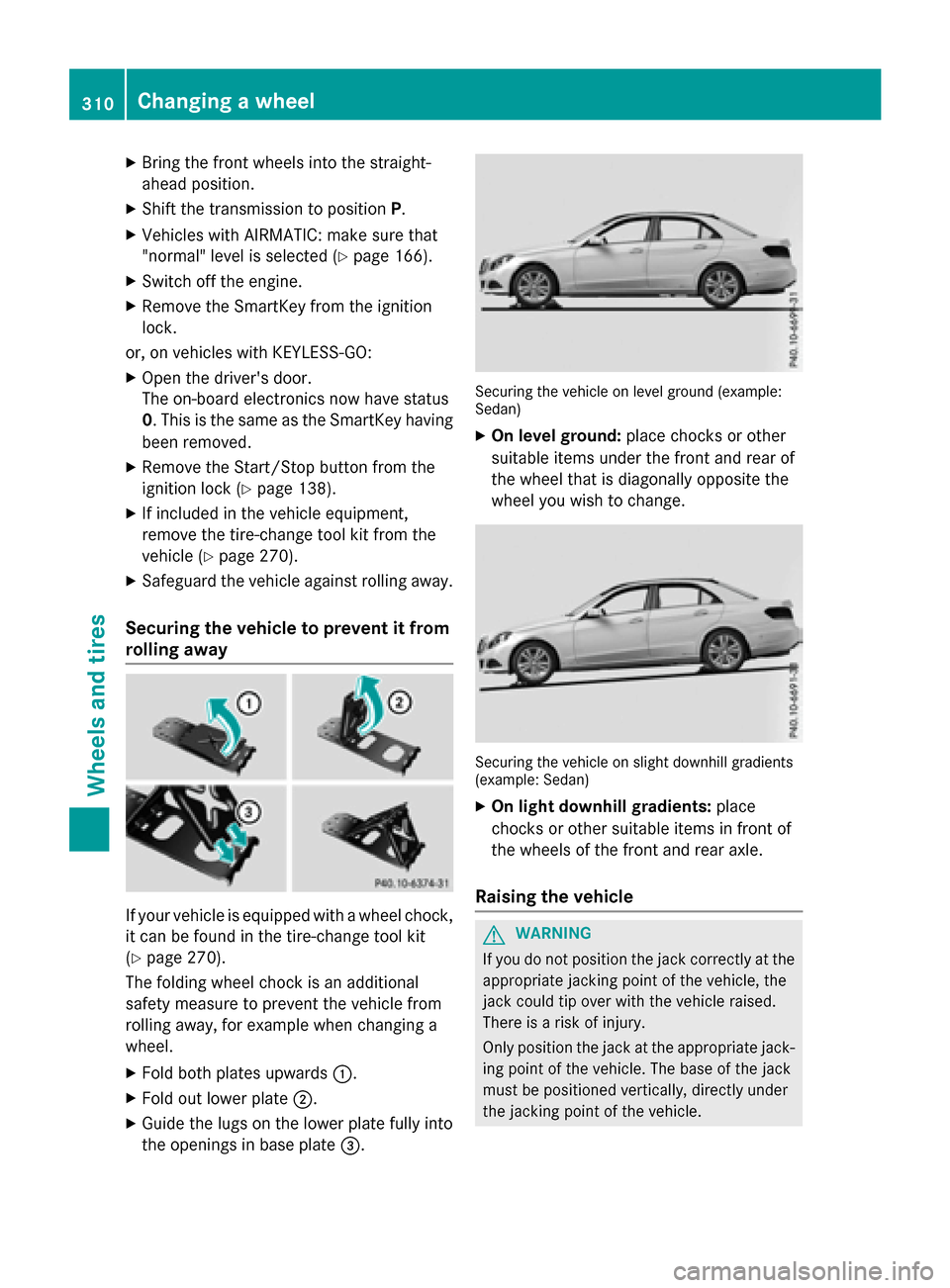
XBring the front wheels into the straight-
ahead position.
XShift the transmission to positionP.
XVehicles with AIRMATIC: make sure that
"normal" level is selected (
Ypage 166).
XSwitch off the engine.
XRemove the SmartKey from the ignition
lock.
or, on vehicles with KEYLESS ‑GO:
XOpen the driver's door.
The on-board electronics now have status
0. This is the same as the SmartKey having
been removed.
XRemove the Start/Stop button from the
ignition lock (
Ypage 138).
XIf included in the vehicle equipment,
remove the tire-change tool kit from the
vehicle (
Ypage 270).
XSafeguard the vehicle against rolling away.
Securing the vehicle to prevent it from
rolling away
If your vehicle is equipped with a wheel chock,
it can be found in the tire-change tool kit
(
Ypage 270).
The folding wheel chock is an additional
safety measure to prevent the vehicle from
rolling away, for example when changing a
wheel.
XFold both plates upwards :.
XFold out lower plate;.
XGuide the lugs on the lower plate fully into
the openings in base plate =.
Securing the vehicle on level ground (example:
Sedan)
XOn level ground:place chocks or other
suitable items under the front and rear of
the wheel that is diagonally opposite the
wheel you wish to change.
Securing the vehicle on slight downhill gradients
(example: Sedan)
XOn light downhill gradients: place
chocks or other suitable items in front of
the wheels of the front and rear axle.
Raising the vehicle
GWARNING
If you do not position the jack correctly at the
appropriate jacking point of the vehicle, the
jack could tip over with the vehicle raised.
There is a risk of injury.
Only position the jack at the appropriate jack-
ing point of the vehicle. The base of the jack
must be positioned vertically, directly under
the jacking point of the vehicle.
310Changing a wheel
Wheels and tires
Page 313 of 350
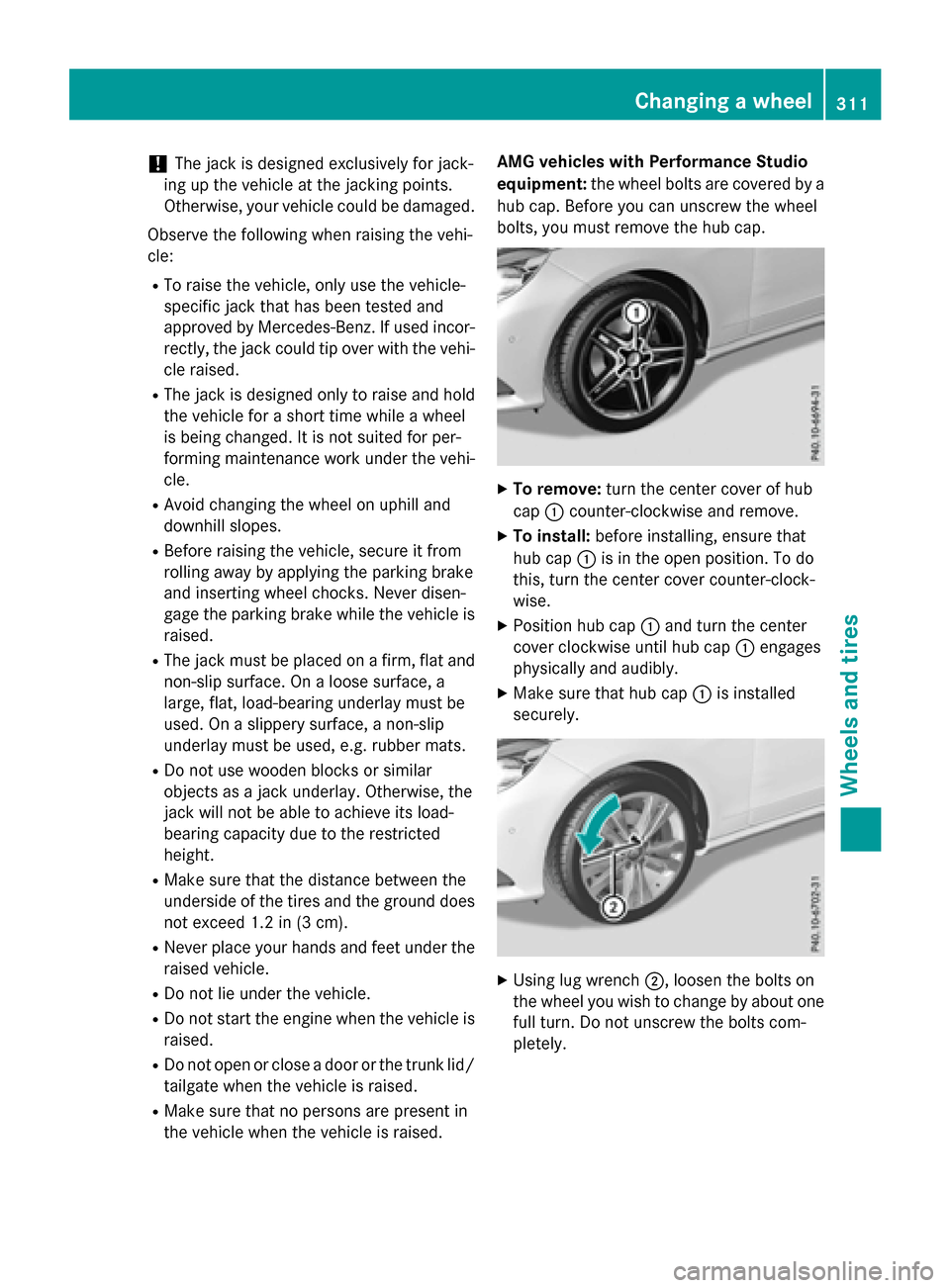
!The jack is designed exclusively for jack-
ing up the vehicle at the jacking points.
Otherwise, your vehicle could be damaged.
Observe the following when raising the vehi-
cle:
RTo raise the vehicle, only use the vehicle-
specific jack that has been tested and
approved by Mercedes-Benz. If used incor-
rectly, the jack could tip over with the vehi- cle raised.
RThe jack is designed only to raise and hold
the vehicle for a short time while a wheel
is being changed. It is not suited for per-
forming maintenance work under the vehi-
cle.
RAvoid changing the wheel on uphill and
downhill slopes.
RBefore raising the vehicle, secure it from
rolling away by applying the parking brake
and inserting wheel chocks. Never disen-
gage the parking brake while the vehicle is
raised.
RThe jack must be placed on a firm, flat andnon-slip surface. On a loose surface, a
large, flat, load-bearing underlay must be
used. On a slippery surface, a non-slip
underlay must be used, e.g. rubber mats.
RDo not use wooden blocks or similar
objects as a jack underlay. Otherwise, the
jack will not be able to achieve its load-
bearing capacity due to the restricted
height.
RMake sure that the distance between the
underside of the tires and the ground does
not exceed 1.2 in (3 cm).
RNever place your hands and feet under the
raised vehicle.
RDo not lie under the vehicle.
RDo not start the engine when the vehicle is
raised.
RDo not open or close a door or the trunk lid/
tailgate when the vehicle is raised.
RMake sure that no persons are present in
the vehicle when the vehicle is raised. AMG vehicles with Performance Studio
equipment:
the wheel bolts are covered by a
hub cap. Before you can unscrew the wheel
bolts, you must remove the hub cap.
XTo remove: turn the center cover of hub
cap :counter-clockwise and remove.
XTo install: before installing, ensure that
hub cap :is in the open position. To do
this, turn the center cover counter-clock-
wise.
XPosition hub cap :and turn the center
cover clockwise until hub cap :engages
physically and audibly.
XMake sure that hub cap :is installed
securely.
XUsing lug wrench ;, loosen the bolts on
the wheel you wish to change by about one
full turn. Do not unscrew the bolts com-
pletely.
Changing a wheel311
Wheels and tires
Z
Page 314 of 350
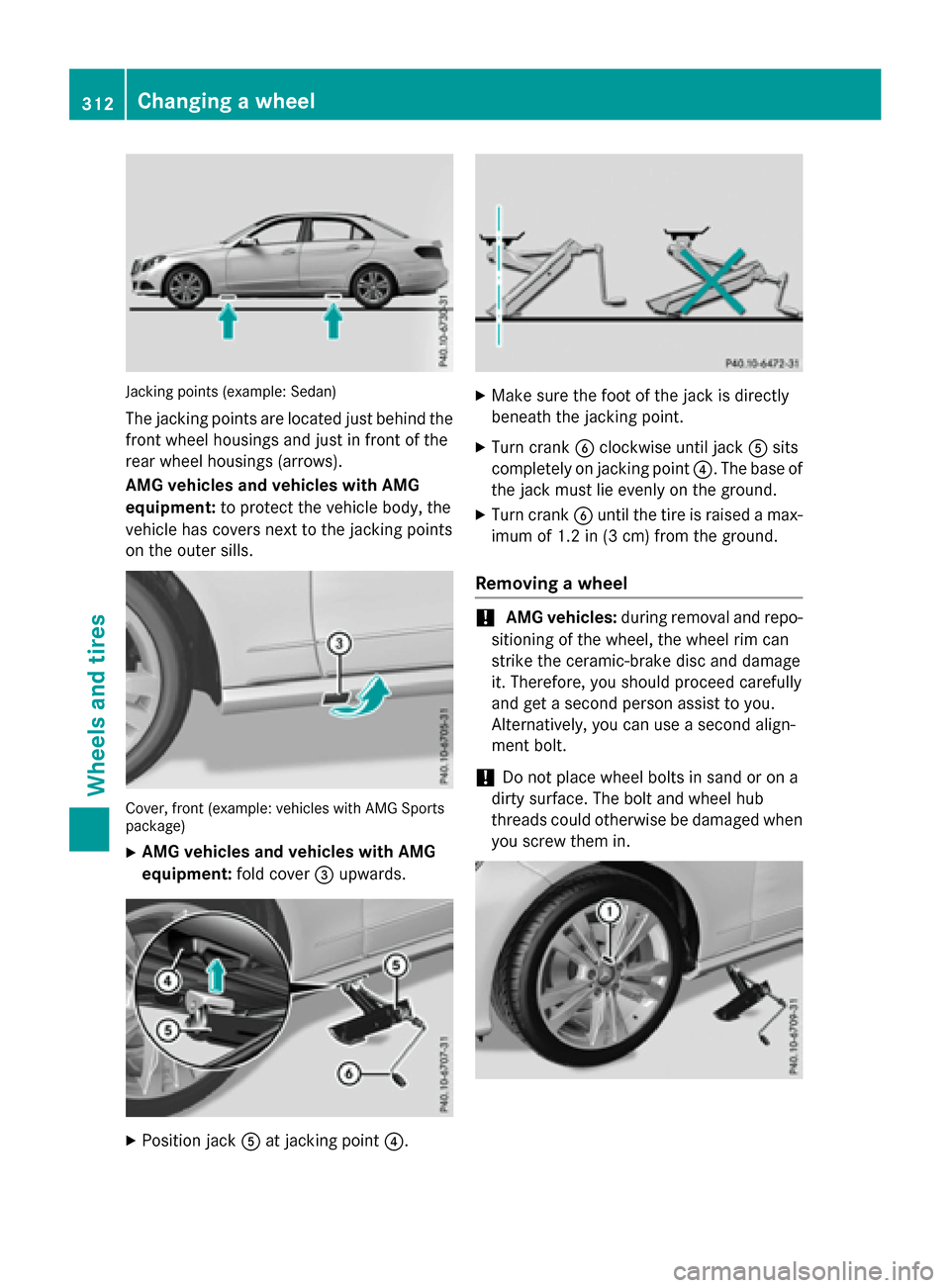
Jacking points (example: Sedan)
The jacking points are located just behind thefront wheel housings and just in front of the
rear wheel housings (arrows).
AMG vehicles and vehicles with AMG
equipment: to protect the vehicle body, the
vehicle has covers next to the jacking points
on the outer sills.
Cover, front (example: vehicles with AMG Sports
package)
XAMG vehicles and vehicles with AMG
equipment: fold cover=upwards.
XPosition jack Aat jacking point ?.
XMake sure the foot of the jack is directly
beneath the jacking point.
XTurn crankBclockwise until jack Asits
completely on jacking point ?. The base of
the jack must lie evenly on the ground.
XTurn crank Buntil the tire is raised a max-
imum of 1.2 in (3 cm) from the ground.
Removing a wheel
!AMG vehicles: during removal and repo-
sitioning of the wheel, the wheel rim can
strike the ceramic-brake disc and damage
it. Therefore, you should proceed carefully
and get a second person assist to you.
Alternatively, you can use a second align-
ment bolt.
!Do not place wheel bolts in sand or on a
dirty surface. The bolt and wheel hub
threads could otherwise be damaged when
you screw them in.
312Changing a wheel
Wheels and tires
Page 315 of 350
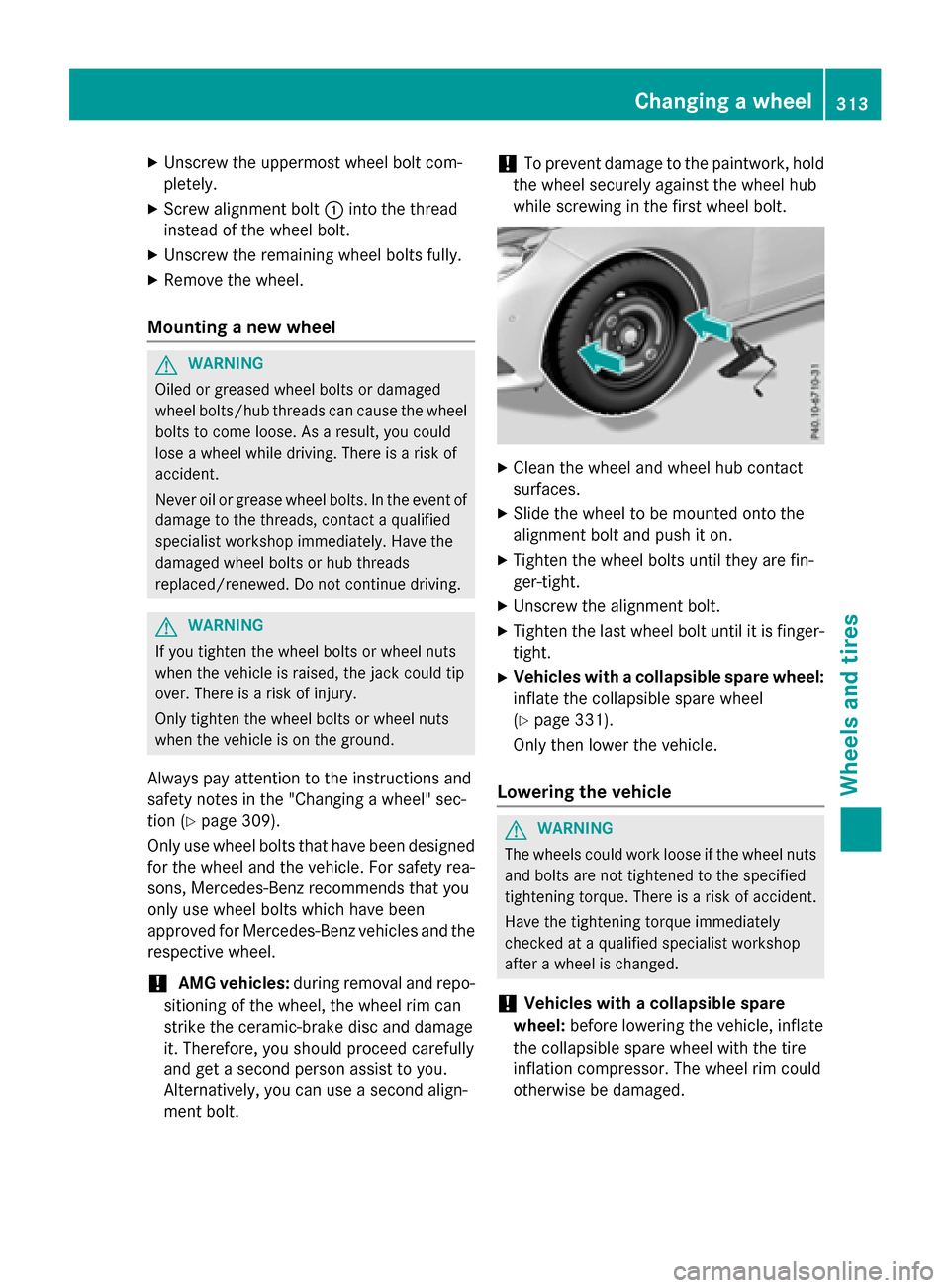
XUnscrew the uppermost wheel bolt com-
pletely.
XScrew alignment bolt:into the thread
instead of the wheel bolt.
XUnscrew the remaining wheel bolts fully.
XRemove the wheel.
Mounting a new wheel
GWARNING
Oiled or greased wheel bolts or damaged
wheel bolts/hub threads can cause the wheel bolts to come loose. As a result, you could
lose a wheel while driving. There is a risk of
accident.
Never oil or grease wheel bolts. In the event of
damage to the threads, contact a qualified
specialist workshop immediately. Have the
damaged wheel bolts or hub threads
replaced/renewed. Do not continue driving.
GWARNING
If you tighten the wheel bolts or wheel nuts
when the vehicle is raised, the jack could tip
over. There is a risk of injury.
Only tighten the wheel bolts or wheel nuts
when the vehicle is on the ground.
Always pay attention to the instructions and
safety notes in the "Changing a wheel" sec-
tion (
Ypage 309).
Only use wheel bolts that have been designed for the wheel and the vehicle. For safety rea-
sons, Mercedes-Benz recommends that you
only use wheel bolts which have been
approved for Mercedes-Benz vehicles and the
respective wheel.
!AMG vehicles: during removal and repo-
sitioning of the wheel, the wheel rim can
strike the ceramic-brake disc and damage
it. Therefore, you should proceed carefully
and get a second person assist to you.
Alternatively, you can use a second align-
ment bolt.
!To prevent damage to the paintwork, hold
the wheel securely against the wheel hub
while screwing in the first wheel bolt.
XClean the wheel and wheel hub contact
surfaces.
XSlide the wheel to be mounted onto the
alignment bolt and push it on.
XTighten the wheel bolts until they are fin-
ger-tight.
XUnscrew the alignment bolt.
XTighten the last wheel bolt until it is finger-
tight.
XVehicles with a collapsible spare wheel:
inflate the collapsible spare wheel
(
Ypage 331).
Only then lower the vehicle.
Lowering the vehicle
GWARNING
The wheels could work loose if the wheel nuts and bolts are not tightened to the specified
tightening torque. There is a risk of accident.
Have the tightening torque immediately
checked at a qualified specialist workshop
after a wheel is changed.
!Vehicles with a collapsible spare
wheel: before lowering the vehicle, inflate
the collapsible spare wheel with the tire
inflation compressor. The wheel rim could
otherwise be damaged.
Changing a wheel313
Wheels and tires
Z
Page 316 of 350
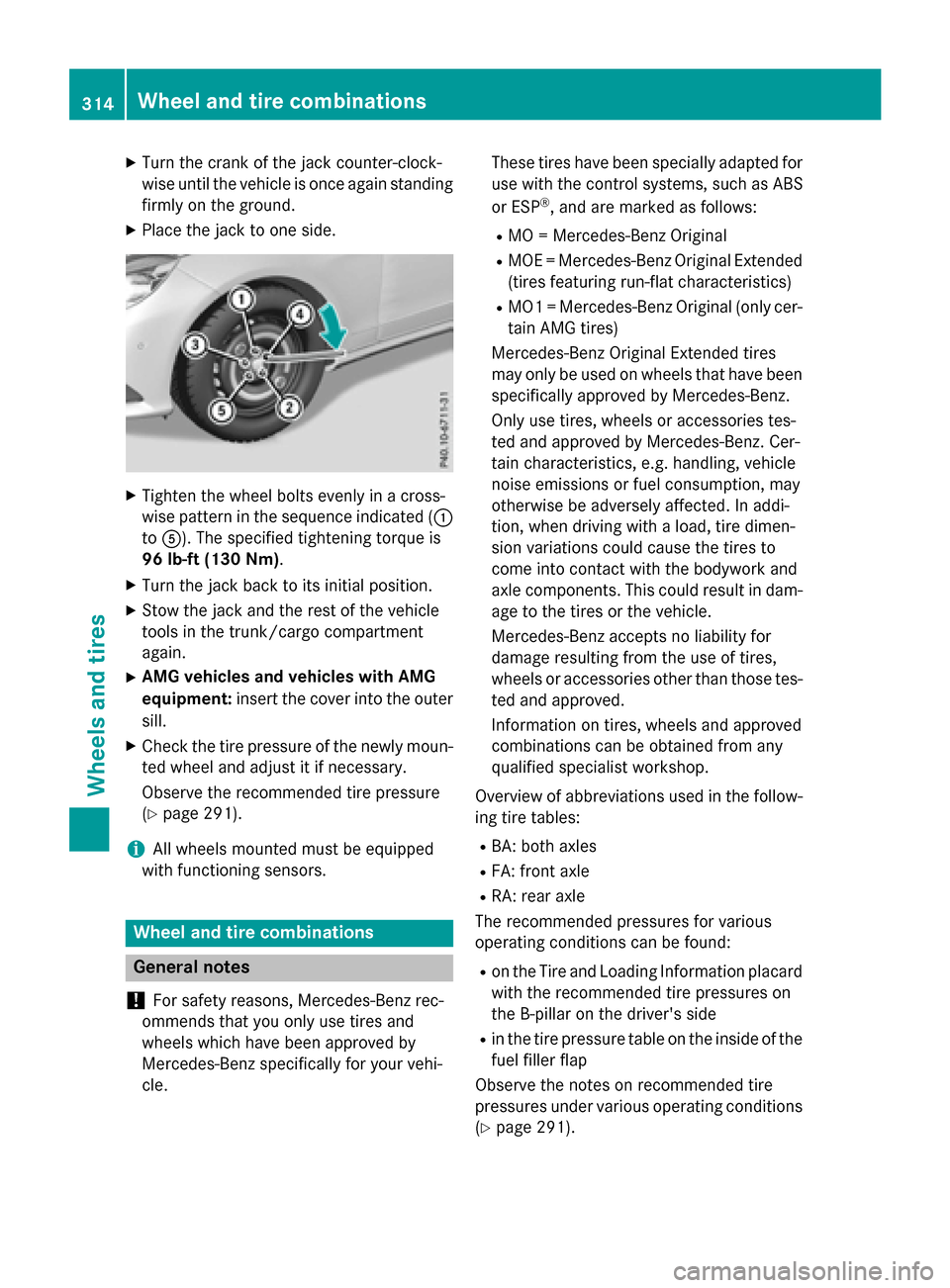
XTurn the crank of the jack counter-clock-
wise until the vehicle is once again standing
firmly on the ground.
XPlace the jack to one side.
XTighten the wheel bolts evenly in a cross-
wise pattern in the sequence indicated (:
to A). The specified tightening torque is
96 lb-ft (130 Nm).
XTurn the jack back to its initial position.
XStow the jack and the rest of the vehicle
tools in the trunk/cargo compartment
again.
XAMG vehicles and vehicles with AMG
equipment: insert the cover into the outer
sill.
XCheck the tire pressure of the newly moun-
ted wheel and adjust it if necessary.
Observe the recommended tire pressure
(
Ypage 291).
iAll wheels mounted must be equipped
with functioning sensors.
Wheel and tire combinations
General notes
!
For safety reasons, Mercedes-Benz rec-
ommends that you only use tires and
wheels which have been approved by
Mercedes-Benz specifically for your vehi-
cle. These tires have been specially adapted for
use with the control systems, such as ABS
or ESP
®, and are marked as follows:
RMO = Mercedes-Benz Original
RMOE = Mercedes-Benz Original Extended
(tires featuring run-flat characteristics)
RMO1 = Mercedes-Benz Original (only cer-
tain AMG tires)
Mercedes-Benz Original Extended tires
may only be used on wheels that have been
specifically approved by Mercedes-Benz.
Only use tires, wheels or accessories tes-
ted and approved by Mercedes-Benz. Cer-
tain characteristics, e.g. handling, vehicle
noise emissions or fuel consumption, may
otherwise be adversely affected. In addi-
tion, when driving with a load, tire dimen-
sion variations could cause the tires to
come into contact with the bodywork and
axle components. This could result in dam-
age to the tires or the vehicle.
Mercedes-Benz accepts no liability for
damage resulting from the use of tires,
wheels or accessories other than those tes-
ted and approved.
Information on tires, wheels and approved
combinations can be obtained from any
qualified specialist workshop.
Overview of abbreviations used in the follow-
ing tire tables:
RBA: both axles
RFA: front axle
RRA: rear axle
The recommended pressures for various
operating conditions can be found:
Ron the Tire and Loading Information placard with the recommended tire pressures on
the B-pillar on the driver's side
Rin the tire pressure table on the inside of the
fuel filler flap
Observe the notes on recommended tire
pressures under various operating conditions
(
Ypage 291).
314Wheel and tire combinations
Wheels and tires
Page 317 of 350
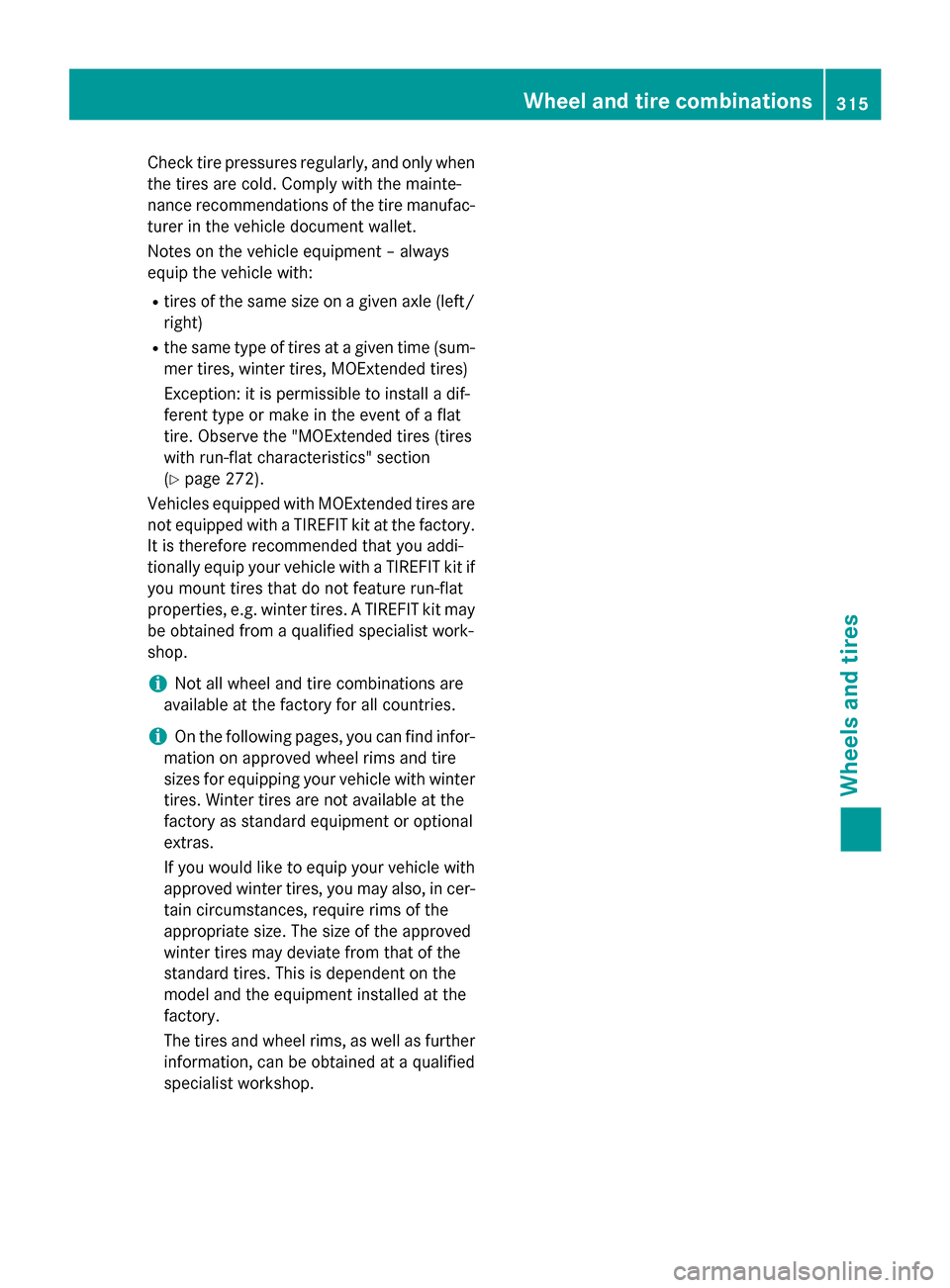
Check tire pressures regularly, and onlywhen
the tires are cold. Comply with the mainte-
nance recommendations of the tire manufac-
turer inthe vehicle document wallet.
Notes on the vehicle equipment – always
equip the vehicle with:
Rtires of the same size on a given axle (left/
right)
Rthe same type of tires at a given time (sum- mer tires, winter tires, MOExtended tires)
Exception: it ispermissible to install a dif-
ferent type or make in the event of a flat
tire. Observe the "MOExtended tires (tires
wit h run-flat characteristics" section
(
Ypage 272).
Vehicle s equipped with MOExtended tires are
not equipp ed with a TIREFIT kit at the factory.
It is therefore recommended that you addi-
tionally equip your vehicle with a TIREFIT kit if
you mount tires that donot feature run-flat
properties, e.g. winter tires. A TIREFIT kit may
be obtained from a qualified specialist work-
shop.
iNot all wheel and tire co mbinations are
availab leat the factory for all countries.
iOn the fol lowing pages, you can find infor-
mation on approved wheel rims and tire
sizes for equipping your vehicle withwin ter
tires. Winter tires are not available at the
factory as standard equipment or optional
ex tras.
I
f you would like to equip your vehicle with
appr oved winter tires, you may also, incer-
tain circumstances, require rims of the
appr opriate size. The size of the approved
win ter tires may deviate from that of the
standard tires. This is dependent on the
model and the equipment installed at the
factory.
The tires and wheel rims, as wellas further
information, can beobtained at a qualified
specialist workshop.
Wheel and tire combinations315
Wheels and tires
Z
Page 318 of 350
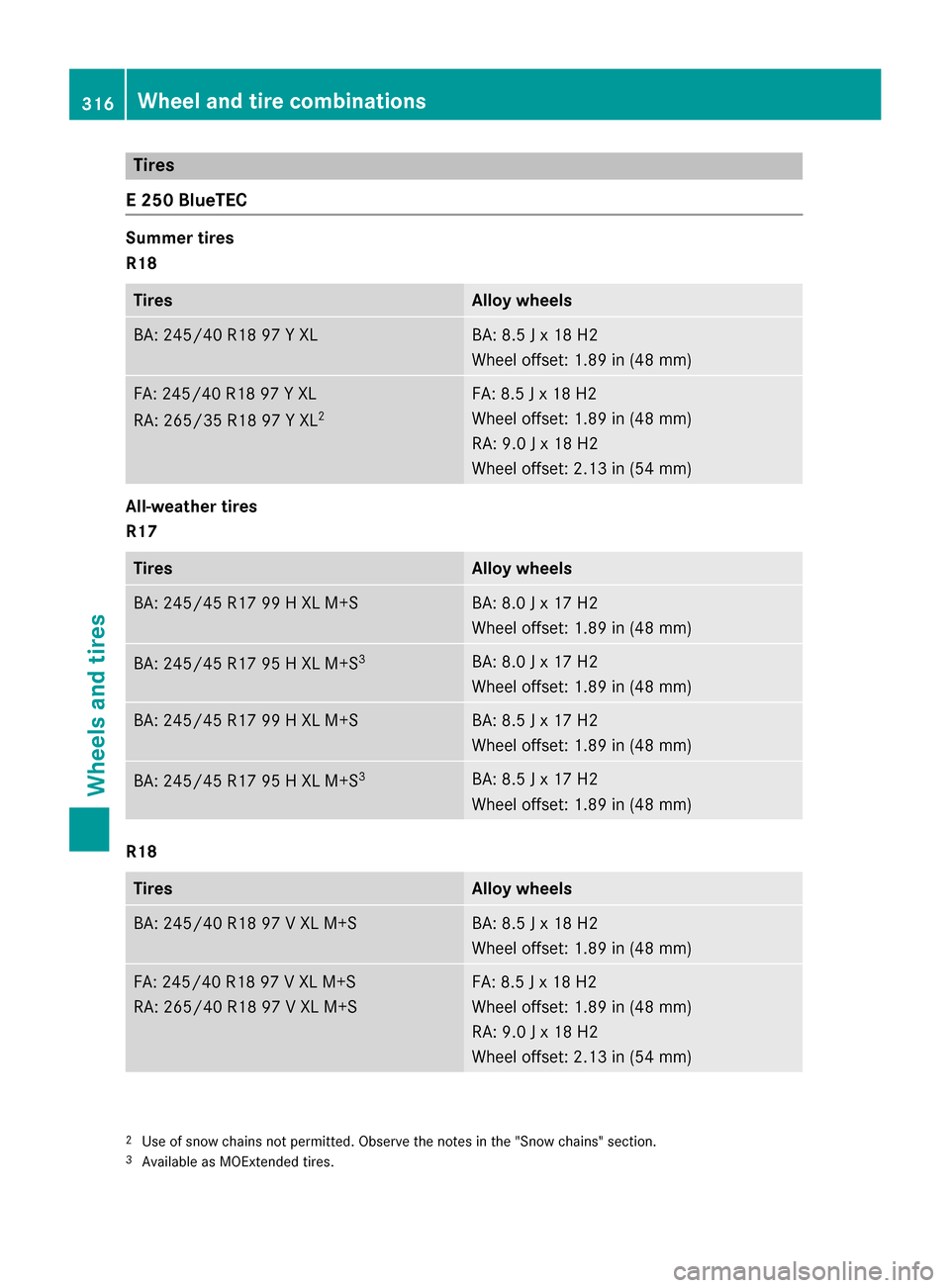
Tires
E 250 BlueTEC
Summer tires
R18
TiresAlloy wheels
BA: 245/40 R1897 YXLBA: 8.5 J x 18 H2
Wheel offset: 1.89 in (48 mm)
FA: 245/40 R18 97 Y XL
RA: 265/35 R18 97 Y XL
2
FA: 8.5 J x 18 H2
Wheel offset: 1.89 in (48 mm)
RA: 9.0 J x 18 H2
Wheel offset: 2.13 in (54 mm)
All-weather tires
R17
TiresAlloy wheels
BA: 245/45 R17 99 H XL M+SBA: 8.0 J x 17 H2
Wheel offset: 1.89 in (48 mm)
BA: 245/45 R17 95 H XL M+S3BA: 8.0 J x 17 H2
Wheel offset: 1.89 in (48 mm)
BA: 245/45 R17 99 H XL M+SBA: 8.5 J x 17 H2
Wheel offset: 1.89 in (48 mm)
BA: 245/45 R17 95 H XL M+S3BA: 8.5 J x 17 H2
Wheel offset: 1.89 in (48 mm)
R18
TiresAlloy wheels
BA: 245/40 R18 97 V XL M+SBA: 8.5 J x 18 H2
Wheel offset: 1.89 in (48 mm)
FA: 245/40 R18 97 V XL M+S
RA: 265/40 R18 97 V XL M+SFA: 8.5 J x 18 H2
Wheel offset: 1.89 in (48 mm)
RA: 9.0 J x 18 H2
Wheel offset: 2.13 in (54 mm)
2Use of snow chains not permitted. Observe the notes in the "Snow chains" section.3Available as MOExtended tires.
316Wheel and tire combinations
Wheels and tires
Page 319 of 350
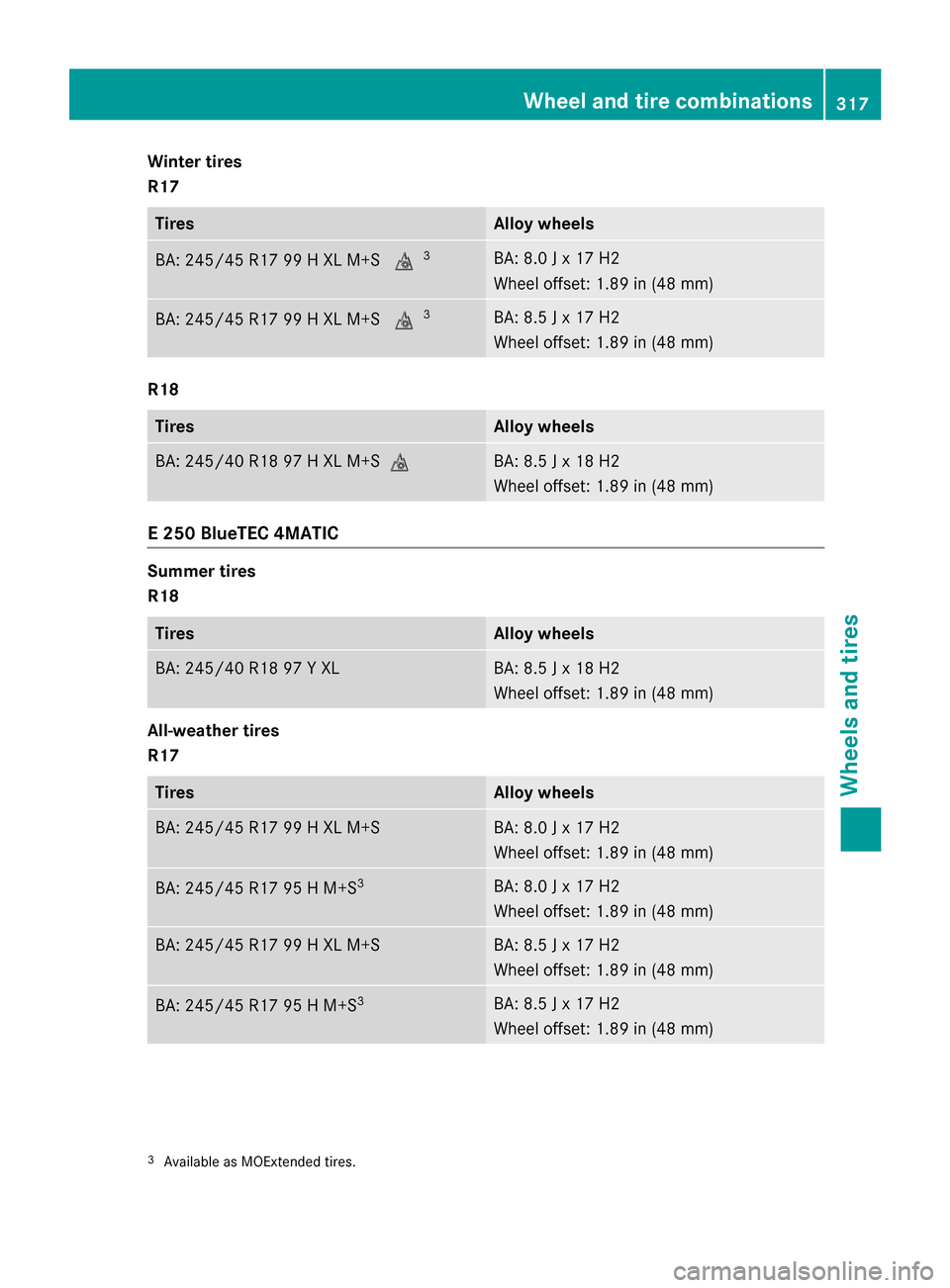
Winter tires
R17
TiresAlloy wheels
BA: 245/45 R17 99 H XL M+Si3BA: 8.0 J x 17 H2
Wheel offset: 1.89 in (48 mm)
BA: 245/45 R17 99 H XL M+Si3BA: 8.5 J x 17 H2
Wheel offset: 1.89 in (48 mm)
R18
TiresAlloy wheels
BA: 245/40 R18 97 H XL M+SiBA: 8.5 J x 18 H2
Wheel offset: 1.89 in (48 mm)
E 250 BlueTEC 4MATIC
Summer tires
R18
TiresAlloy wheels
BA: 245/40 R18 97 Y XLBA: 8.5 J x 18 H2
Wheel offset: 1.89 in (48 mm)
All-weather tires
R17
TiresAlloy wheels
BA: 245/45 R17 99 H XL M+SBA: 8.0 J x 17 H2
Wheel offset: 1.89 in (48 mm)
BA: 245/45 R17 95 H M+S3BA: 8.0 J x 17 H2
Wheel offset: 1.89 in (48 mm)
BA: 245/45 R17 99 H XL M+SBA: 8.5 J x 17 H2
Wheel offset: 1.89 in (48 mm)
BA: 245/45 R17 95 H M+S3BA: 8.5 J x 17 H2
Wheel offset: 1.89 in (48 mm)
3Available as MOExtended tires.
Wheel and tire combinations317
Wheels and tires
Z
Page 320 of 350
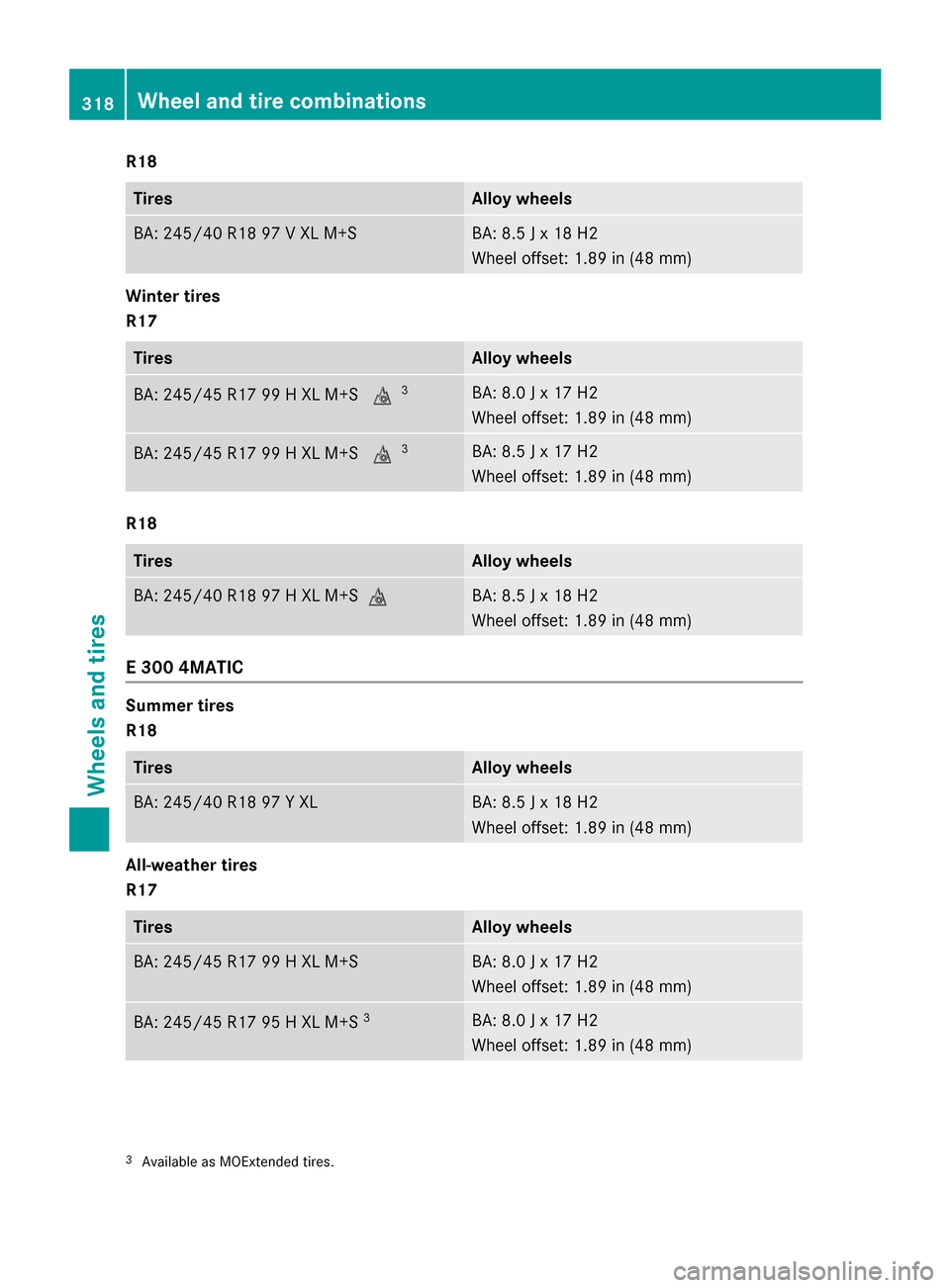
R18
TiresAlloy wheels
BA: 245/40 R18 97 V XL M+SBA: 8.5 J x 18 H2
Wheel offset: 1.89 in (48 mm)
Winter tires
R17
TiresAlloy wheels
BA: 245/45 R17 99 H XL M+Si3BA: 8.0 J x 17 H2
Wheel offset: 1.89 in (48 mm)
BA: 245/45 R17 99 H XL M+Si3BA: 8.5 J x 17 H2
Wheel offset: 1.89 in (48 mm)
R18
TiresAlloy wheels
BA: 245/40 R18 97 H XL M+SiBA: 8.5 J x 18 H2
Wheel offset: 1.89 in (48 mm)
E 300 4MATIC
Summer tires
R18
TiresAlloy wheels
BA: 245/40 R18 97 Y XLBA: 8.5 J x 18 H2
Wheel offset: 1.89 in (48 mm)
All-weather tires
R17
TiresAlloy wheels
BA: 245/45 R17 99 H XL M+SBA: 8.0 J x 17 H2
Wheel offset: 1.89 in (48 mm)
BA: 245/45 R17 95 H XL M+S3BA: 8.0 J x 17 H2
Wheel offset: 1.89 in (48 mm)
3Available as MOExtended tires.
318Wheel and tire combinations
Wheels and tires